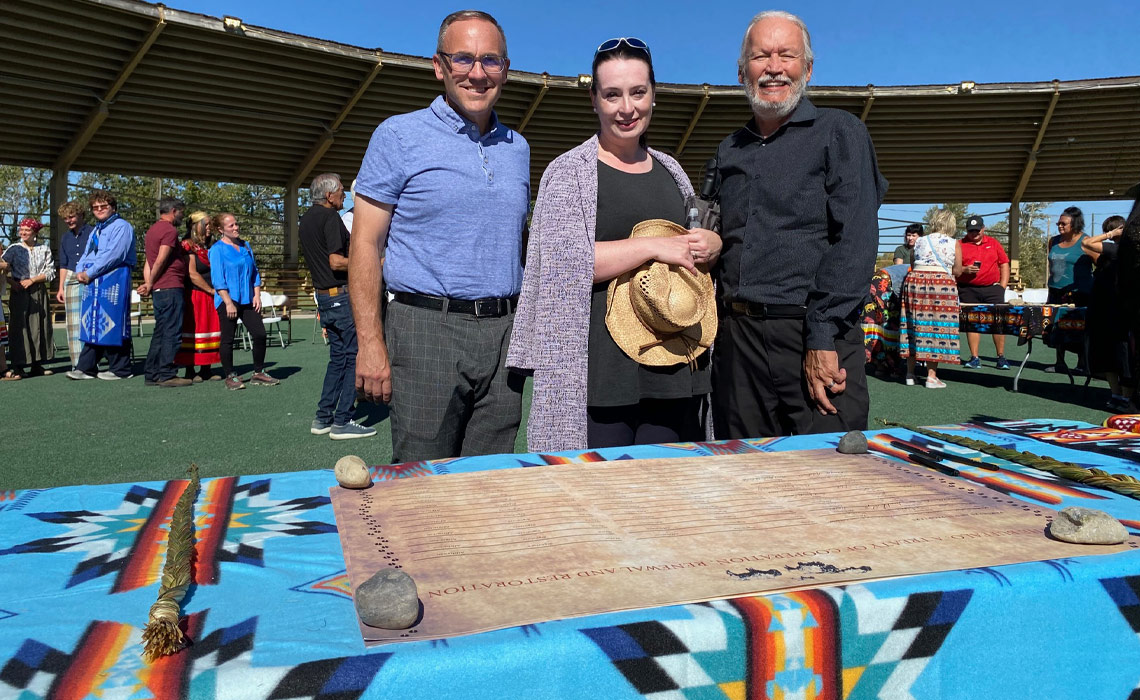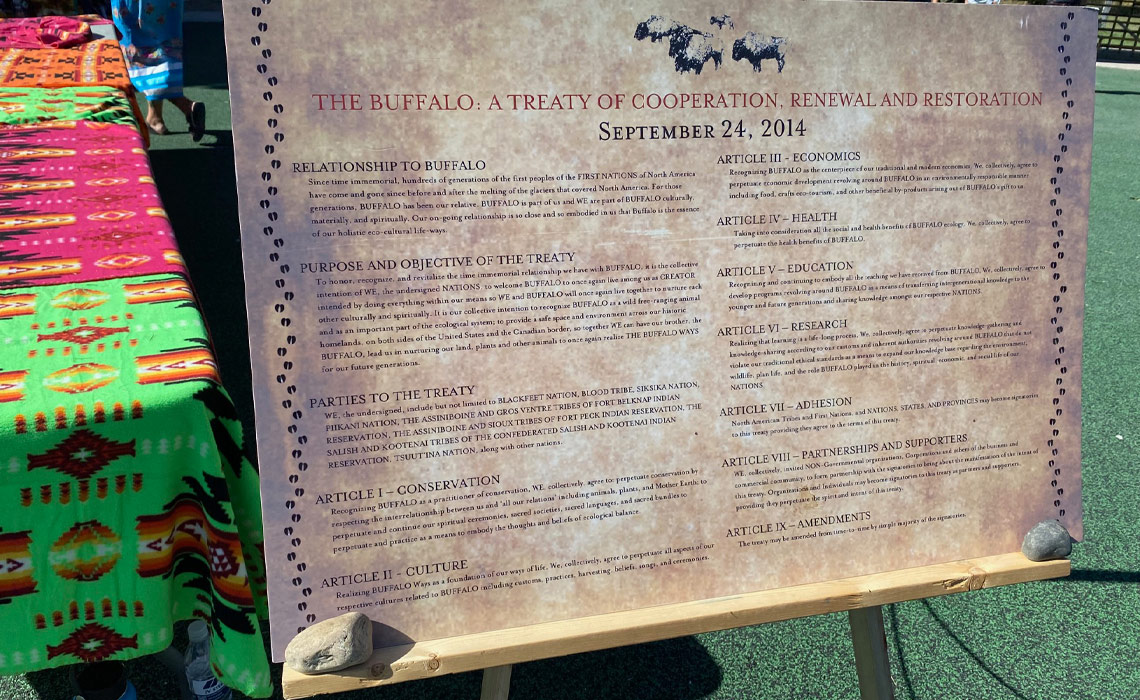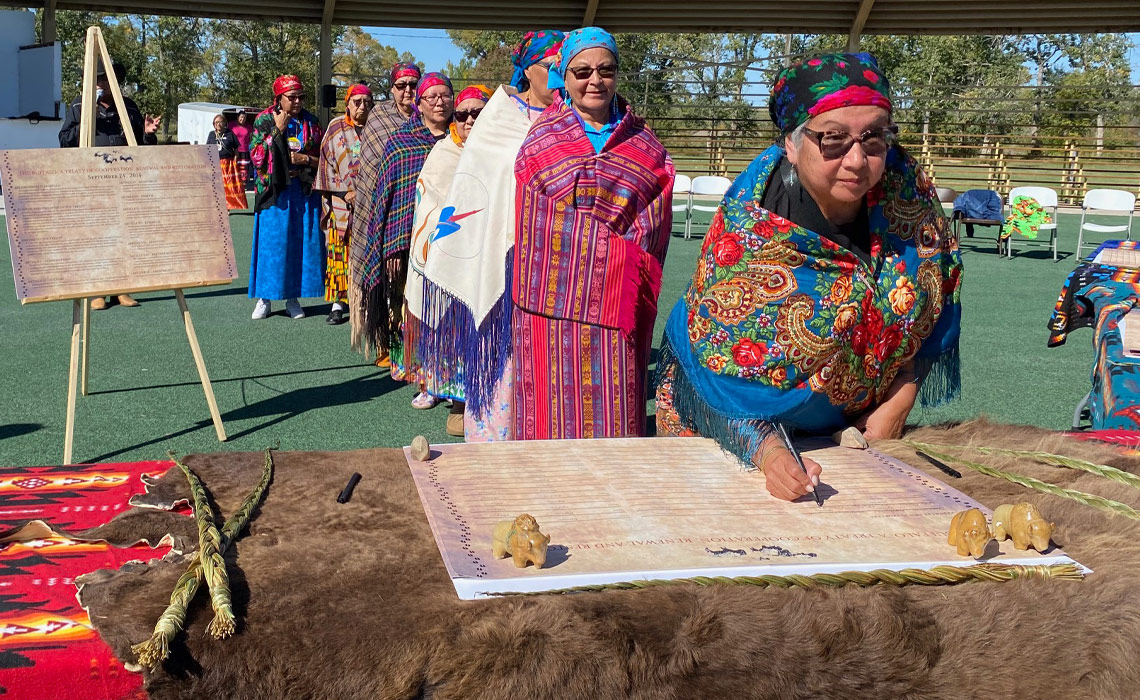Mount Royal University signs on to Buffalo Treaty

While the vast herds of buffalo that once roamed the plains are largely gone, the cultural, spiritual and ecological significance of the majestic mammal remain as efforts continue to restore and protect its numbers.
On Sept. 25, Mount Royal University took a significant step in advancing its commitment to indigenization and decolonization by signing the Buffalo Treaty, a historic collaboration among First Nations to rejuvenate and restore the buffalo population. The signing ceremony, hosted by the Kainai First Nation and the International Buffalo Relations Institute, took place in Stand Off, Alta., marking the 10th anniversary of this landmark agreement, and following three days of ceremonies, teachings and songs with new and past signatories from across North America and beyond.
Chad London, provost and vice-president, Academic; John Fischer, interim associate vice-president of indigenization and decolonization; and Melanie Rogers, vice-president of University Advancement represented MRU at the signing ceremony.
“Mount Royal’s participation in the Buffalo Treaty underscores our dedication to enhancing our understanding of treaty-making processes and strengthening relationships with Indigenous communities,” London said. “The treaty aligns with MRU’s strategic plan and academic plan, reflecting the University's ongoing efforts in indigenization and decolonization. The signing reaffirms MRU’s commitment, first demonstrated through the Iniskim Centre’s agreement in 2016, to ensure appropriate inclusion of Indigenous perspectives and teachings into its programs and campus culture.”
The treaty emphasizes the buffalo's role in Indigenous cultures as a source of food, clothing, and tools, as well as a symbol of resilience and strength. It commits the signatories to work together to reintroduce buffalo herds, protect their natural habitats, and ensure their sustainable management. Known by various names such as bison, iinnii, tatanka, and paskwâwimostos, the buffalo holds profound significance for these communities. The treaty symbolizes a deep cultural and spiritual connection, aiming to restore the buffalo to its rightful place within the ecosystem and cultural practices of Indigenous peoples.

Beyond ecological goals, the Buffalo Treaty also represents a broader movement for Indigenous rights and cultural revitalization. It has been signed by more than 30 tribes and First Nations, highlighting the enduring connection between Indigenous peoples and the buffalo, as well as their shared responsibility to protect this keystone species for future generations.
“The signing of the Buffalo Treaty by Mount Royal University represents a pivotal moment in strengthening its ties with Indigenous communities and deepening its commitment to cultural and educational integration. This historic event not only celebrates the 10th anniversary of the treaty, but also marks a new chapter for MRU in embracing and promoting Indigenous knowledge,” Fischer said.
“As MRU embarks on this journey, the University is poised to enrich its academic programs and campus life with the profound teachings of the buffalo, fostering a more inclusive and respectful educational environment.”
Buffalo teachings at MRU
The significance of the Buffalo Treaty and support for MRU’s involvement comes from the University’s Traditional Thinkers Advisory Council, including Elders Bruce Starlight and Alice Kaquitts. Starlight recalls that the Tsuut’ina Nation was an initial signatory and that Tsuut’ina brought in a herd of buffalo in the 1970s. Kaquitts, who emphasizes the buffalo's role in Stoney Nakoda ceremonies, recalls that Stoney Nakoda also brought in a herd in the early 1970s. She stresses the importance of a deeper understanding of the buffalo’s role and relationship to culture and spirituality.
Buffalo teachings have informed the indigenization of MRU. The Iniskim Centre was named by Kainai elders and the songs and stories of the Iniskim is a buffalo teaching. In 2022, Elder Doreen Spence and Elder Roy Bear Chief presented a Buffalo Robe to the University. The teachings were ceremonially painted on the robe exhibited in the main entrance of MRU Recreation.
Medicine Trail Coordinator Dion Simon painted the buffalo mural near Security Services and drew buffalo (and other animals) for an indigenization feature in Summit magazine. The idea for Ini Awato, on the west side of Charlton Pond, came to Elder Miiksika’am in a vision after speaking to the president of the University. It was developed by the Grounds department and the Faculty of Science and Technology and symbolizes a buffalo leading a herd in the direction of Buffalo Lake, a sacred site. It represents the importance of leadership and perseverance in teaching and learning.
MRU is already connected to the treaty in a variety of ways. Simon and Noah Arney of Iniskim attended a signing ceremony in Banff in 2016 and signed on behalf of the Centre. Paulette Fox presented “Returning the Buffalo” in 2016 as part of the ASTEP (Aboriginal Science and Technology Education Program) Speaker Series, focusing on the cultural significance of the buffalo. In 2017, a Canada 150 event named the Calgary Celebration took place at the Leacock Theatre as a partnership between Parks Canada, the Eleanor Luxton Historical Society, Bison Belong, and the Iniskim Centre. It celebrated the re-introduction of free-roaming bison in Banff and featured Dr. Leroy Little Bear and Elder Miiksika’am.

For nearly a decade, MRU has championed the basis of the treaty and following the signing MRU plans to further advance the teachings of the buffalo.
The new Indigenous Strategic Plan will include strategies to advance educational and research goals related to the treaty. Proposed initiatives include field schools, on-campus ceremonies, guest lectures, and art exhibitions. The Bison Exhibit at Heritage Park from September 2024 to February 2025 will provide an opportunity for the MRU community to engage with buffalo teachings. Additionally, presentations by Bill Snow and screenings of Tasha Hubbard’s documentary, Singing Back the Buffalo, are planned to enhance the university's educational goals.
“The signing of the Buffalo Treaty is a pivotal moment in strengthening Mount Royal’s ties with Indigenous communities and deepening its commitment to cultural and educational integration,” Fisher said. “This historic event marks a new chapter for MRU in embracing and promoting Indigenous knowledge. As we embark on this journey, the university is poised to enrich its academic programs and campus life with the profound teachings of the buffalo, fostering a more inclusive and respectful educational environment.”

